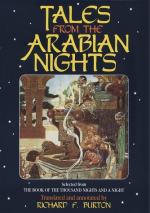When we find a popular (i.e. oral) European tale reproduce the most minute details of a story found in The Nights, we should conclude that it has been derived therefrom and within quite recent times, and such I am now disposed to think is the case of the Roman version of Aladdin given by Miss Busk under the title of “How Cajusse was Married,” notwithstandtng the circumstance that the old woman from whom it was obtained was almost wholly illiterate. A child who could read might have told the story out of Galland to his or her nurse, through whom it would afterwards assume local colour, with some modifications of the details. But stories having all the essential features of the tale of Aladdin were known throughout Europe long before Galland’s work was published, and in forms strikingly resembling other Asiatic versions, from one of which the Arabian tale must have been adapted. The incidents of the Magician and Aladdin at the Cave, and the conveying of the Princess and the vazir’s son three nights in succession to Aladdin’s house (which occurs, in modified forms, in other tales in The Nights), I consider as the work of the Arabian author. Stripped of these particulars, the elements of the tale are identical in all versions, Eastern and Western: a talisman, by means of which its possessor can command unlimited wealth, &c.; its loss and the consequent disappearance of the magnificent palace erected by supernatural agents who are subservient to the owner of the talisman, and finally its recovery together with the restoration of the palace to its original situation. The Arabian tale is singular in the circumstance of the talisman (the Lamp) being recovered by human means—by the devices of the hero himself, in fact, since in all the European and the other Asiatic forms of the story it is recovered by, as it was first obtained from, grateful animals. To my mind, this latter is the pristine form of the tale, and points to a Buddhist origin—mercy to all hying creatures being one of the leading doctrines of pure Buddhism.




